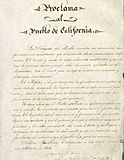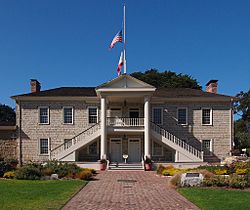Constitution of California facts for kids
Quick facts for kids Constitution of the State of CaliforniaConstitución del Estado de California (Spanish) |
|
|---|---|
|
Title pages of the original English (left) and Spanish (right) versions of the 1849 Constitution
|
|
| Jurisdiction | State of California |
| Subordinate to | Supreme law of the United States |
| Created | 13 October 1849 |
| Ratified | 7 May 1879 |
| Amendments | 514 |
| Location | California Capitol Museum, Sacramento, California |
| Author(s) | Monterey Convention of 1849 |
| Signatories | 48 delegates |
The Constitution of California (Spanish: Constitución de California) is the main set of rules for the U.S. state of California. It explains how the government of California works. This includes its duties, powers, and different parts. California's first constitution was written in both English and Spanish. It was created by early American settlers and Californios (Hispanic people from California). This happened at the 1849 Constitutional Convention of Monterey. This was after the American Conquest of California and the Mexican–American War. California then joined the United States in 1850. The constitution was later updated and approved again on May 7, 1879.
The California Constitution is one of the longest sets of laws in the world. This is partly because of rules added during the Progressive Era. These rules limited the power of elected officials. But mostly, it's long because of changes made by voters. These changes are called ballot propositions or voter initiatives. They become part of the constitution. This makes California's legal system very flexible. It is currently the eighth longest constitution in the world.
Many rights in the state constitution offer even more protection than the United States Bill of Rights in the U.S. Constitution. For example, in the case of Pruneyard Shopping Center v. Robins, California courts found "free speech" rights in the California Constitution. These rights were broader than those in the First Amendment to the United States Constitution. Also, California's constitution has a stronger rule against "cruel or unusual punishment." The U.S. Constitution's Eighth Amendment only prohibits "cruel and unusual punishment."
Contents
History of California's Constitution
The California Constitution has changed many times since it was first written. It was completely rewritten several times before the current 1879 version. Even the 1879 constitution has been updated many times.
In the early 1900s, people were unhappy with powerful railroad companies. These companies had too much control over California's politics and economy. So, politicians from the Progressive Era found a new way to make changes. They started adding amendments to the state constitution through voter initiatives. This was a way to fix problems they saw. From 1911 to 1986, the California Constitution was changed over 500 times.
The constitution became very long. This led to several attempts to hold a third constitutional convention. These attempts happened in 1897, 1914, 1919, 1930, 1934, and 1947. By 1962, the constitution had about 75,000 words. At that time, only Louisiana's state constitution was longer.
In 1962, voters approved creating a California Constitution Revision Commission. This group worked to make the constitution shorter and clearer from 1964 to 1976. Voters approved their changes in 1966, 1970, 1972, and 1974. The commission removed about 40,000 words from the constitution.
Key Parts of the California Constitution
The California Constitution is one of the longest in the world. Its length is due to several reasons. One reason is the influence of earlier Mexican civil law. Another is a lack of trust in elected officials. Also, many voter initiatives become constitutional amendments. Some amendments created state government agencies, like the State Compensation Insurance Fund. This was to protect these agencies from legal challenges.
Unlike other state constitutions, California's constitution strongly protects cities and counties. It gives them broad powers to govern themselves. For example, charter cities have great power over local matters. Their local laws can even be stronger than state laws. This system also led to the creation of "contract cities." These are cities that pay counties to handle some government services for them.
Article 4, section 8(d) talks about "urgency statutes." These are laws "necessary for immediate preservation of the public peace, health, or safety." If a bill includes such a provision, it must explain why it's urgent. Two-thirds of each house of the Legislature must approve the urgency part of the bill.
Many individual rights in the state constitution are broader than those in the Bill of Rights of the U.S. Constitution.
- One example is the Pruneyard Shopping Center v. Robins case. It found a right to free speech in private shopping centers.
- Another example is the rule against "cruel or unusual punishment." This is stronger than the U.S. Constitution's Eighth Amendment, which says "cruel and unusual."
The constitution also states that women have equal rights in "entering or pursuing a business, profession, vocation, or employment." This was one of the earliest state constitutional equal rights rules.
Two universities are specifically mentioned in the constitution: the University of California (a public university) and Stanford University (a private university). The University of California is one of only nine public universities in the U.S. whose independence from political interference is guaranteed by the state constitution. Since 1900, Stanford has benefited from a rule that protects its property from taxes. This applies as long as the property is used for educational purposes.
How the Constitution is Changed
The California Constitution has two ways to be changed: amendments and revisions. A constitutional revision is a "big change to the entire constitution." An amendment is a smaller change to one or more parts. Both need to be approved by voters through a California ballot proposition. But they are proposed in different ways.
An amendment can be put on the ballot in two ways:
- By a two-thirds vote in the California State Legislature.
- By voters collecting signatures equal to 8% of the votes from the last gubernatorial election. This is called an initiative. The number of signatures needed for amendments is one of the lowest in any U.S. state.
As of 2020, this meant 997,139 signatures were needed. California's population in 2018 was about 39,557,045.
A constitutional revision used to require a constitutional convention. Today, it can be passed if two-thirds of the Legislature approves it, and then a majority of voters approve it. While simpler now, the revision process is still harder to pass than an amendment. Voters cannot propose a constitutional revision through an initiative.
People Who Signed the 1849 Constitution
Many people who signed California's first constitution in 1849 were important figures. The list below includes several Californios (Spanish-speaking residents born in California).
|
|
See also
 In Spanish: Constitución de California para niños
In Spanish: Constitución de California para niños





